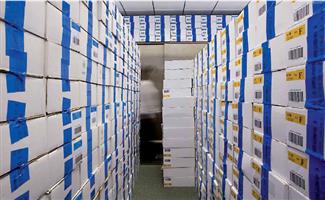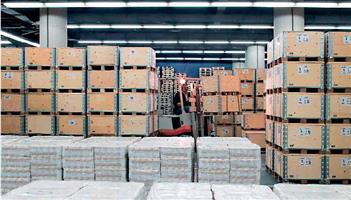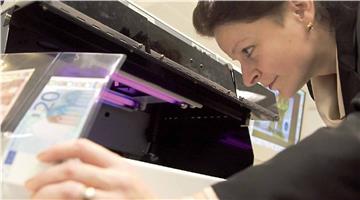Organisation of banknote production
Prior to the introduction of euro cash, each central bank was responsible for producing its own national banknotes.
Since 2002, banknote production has been reorganised in a "pooling scenario". Under this arrangement, each central
bank is responsible for producing a limited number of denominations. But it does so to meet the need for those
particular denominations throughout the euro area. This division of labour enables the Eurosystem to benefit from
economies of scale. It also helps in the efficient operation of the Quality Management System, as there are fewer
production sites for each denomination than there would be without any pooling.
Each year the ECB and the national central banks forecast the likely overall banknote demand, taking into account
the estimated growth in circulation and the replacement of "unfit" banknotes, i.e.worn or dirty banknotes which no
longer meet the set quality standards. The banknote production shares are then allocated to the NCBs according to a
key. Only printing works which are both quality and security-accredited by the ECB can contribute to this output.
Stock and circulation management
The NCBs ensure a smooth and efficient supply of euro banknotes. Potential demand from the market for any
denomination can be met at any time and in the desired quantity, since the NCBs hold banknote stocks. They hold
these stocks for three reasons: firstly, to replace "unfit" banknotes; secondly, to accommodate increases in demand,
such as seasonal fluctuations (e.g. the increased use of cash around Christmas); and thirdly, to meet any unexpected
demand. A Eurosystem database, administered by the ECB, makes it possible to monitor changes in circulation figures
and stocks.


The migration of banknotes between different countries leads to imbalances in the NCBs' stocks. If one NCB is
about to run short of a specific banknote denomination, another NCB with a surplus of that denomination transports
the required number of banknotes by road and/or air in a matter of days. This flexibility has brought efficiency
gains, as it allows NCBs to hold smaller stocks. When the banknotes leave the printing works they are of identical
quality. But their quality deteriorates during circulation: €5 banknotes, for example, become worn and crumpled
more quickly than €50 banknotes, as they are generally treated with less care and pass from hand to hand more often.
A €5 banknote lasts, on average, 15 months before being withdrawn from circulation and destroyed,
while a €50 banknote circulates for 3.5 years.
NCBs use highspeed sorting machines to process banknotes deposited by commercial banks and security carriers.
These machines can check the genuineness and condition of a banknote in a fraction of a second. Banknotes which are
no longer fit for circulation because they are dirty or limp, or have fragments missing, etc. are immediately
shredded. Only clean banknotes are reissued. If banknotes deteriorate in quality during circulation, for example
through wear or soiling, they could become more difficult to use, for example in vending machines. The resulting
lack of public trust in the banknotes could lead to them becoming less widely used as a means of payment. Also,
security features on clean banknotes are easier to check than those on soiled banknotes.
To this extent, common minimum sorting standards contribute to the integrity of the euro.
In cases where banknotes do not often return to the NCBs, maintaining the quality level of banknotes in circulation
is a challenging task. In particular, €5 banknotes, which typically pass from consumers to retailers and back again,
instead of being deposited, have a relatively low return frequency. Some NCBs have therefore created incentives
for the more frequent depositing of €5 banknotes or have temporarily issued only freshly printed banknotes. The ECB
monitors the quality of banknotes in circulation through annual sample surveys. Over the longer title, the Eurosystem
is working on projects which aim to enhance the durability of euro banknotes.
Banknote recycling framework
The cash cycle can be shortened if banks recirculate ("recycle") banknotes which they receive from their
customers. This avoids the transportation of banknotes back to the central bank and their withdrawal again
by that bank. Back in 2002 the ECB established titles of reference for the operation of stand-alone, customeroperated
machines that can receive, process and dispense banknotes, socalled "cash-recycling machines". Only cash-recycling
machines which can detect banknote counterfeits and sort banknotes according to their quality should be used by banks
and other professional cash handlers.
The titles of reference have meanwhile been extended to all forms of banknote recycling. These machines must be
able to detect counterfeit banknotes and to physically separate banknotes which are fit for circulation from those
which are not. Only fit banknotes will be disbursed, while unfit banknotes have to be forwarded to the national
central bank. Counterfeits are reported to the local police. On its website, the ECB has published a list of those
cash-handling and cashrecycling machines which have qualified for banknote recycling. Prior to being admitted to the
euro area market, each machine has to pass a standardised test at an NCB showing that it can reliably detect and
segregate counterfeits and unfit banknotes. The tests need to be repeated annually to ensure that each machine is
performing properly.
After a transitional period, all banks and other professional cash handlers in the euro area will need to either
comply with the regulations for banknote recycling or, alternatively, use their NCBs for banknote deposits/withdrawals.
Counterfeits
Euro banknotes can be used for international payments. This makes them attractive for counterfeiters. Still, the
probability of encountering a counterfeit is very low. In the first half of 2007 some 265,000 counterfeit euro
banknotes were withdrawn from circulation. This is a very small proportion of the 11 billion or so banknotes
currently in circulation.
Virtually all euro counterfeits can be easily distinguished from genuine euro banknotes by simply checking
several security features; no special devices are needed. This method has proved effective, as counterfeiters
concentrate on specific security features, but do not imitate all of these features. Since the introduction of
euro banknotes and coins, the ECB and the NCBs have been monitoring the counterfeit situation very closely. The
ECB's Counterfeit Analysis Centre coordinates the work of the national analysis centres in each EU Member State,
which are either located at the NCBs or attached to national police forces. All analysis centres have access to a
comprehensive technical, statistical and geographical database on counterfeits, the Counterfeit Monitoring System.


This system is located at the ECB and provides real-time information, such as information on the techniques used
by counterfeiters to imitate security features. This knowledge is taken into account in the development of the next
generation of euro banknotes. The ECB cooperates closely with the European Commission (which is responsible for
providing information about counterfeit euro coins), as well as national police forces, Europol and Interpol, all of
which compare data from the Counterfeit Monitoring System with their own crime record data in order to tackle crime.